6+ Sample Photo Licensing Agreement
-
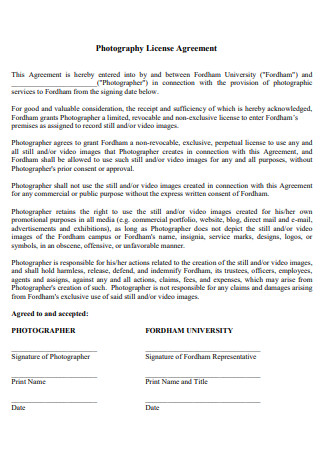
Photography License Agreement Template
download now -
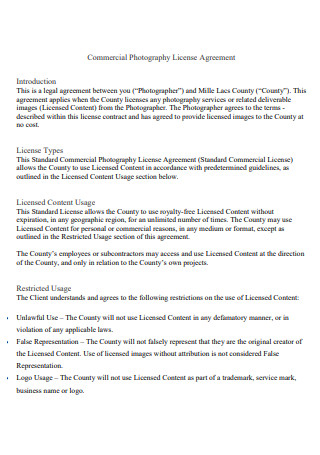
Commercial Photography License Agreement
download now -
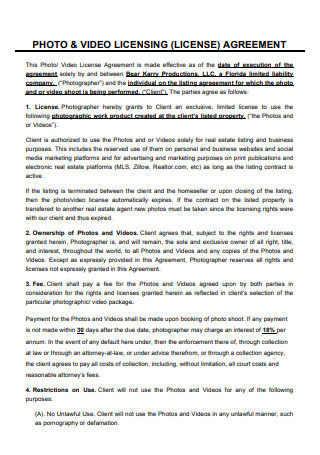
Photo and Video Licensing Agreement
download now -
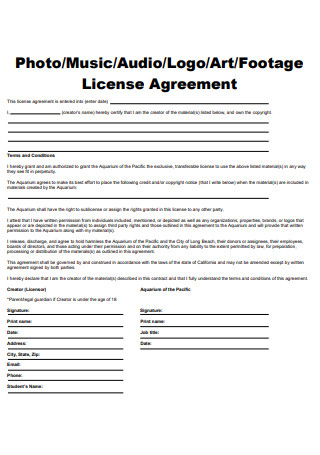
Photo License Agreement Example
download now -
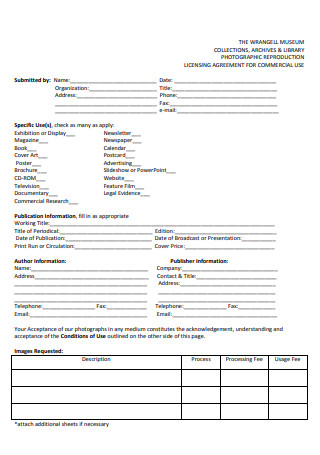
Photographic Licensing Agreement
download now -
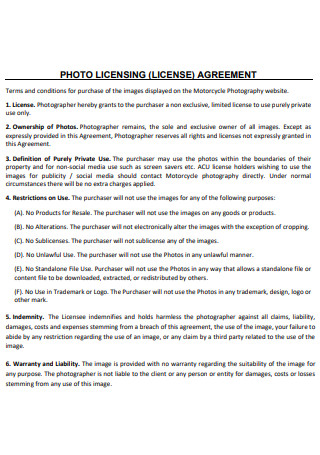
Printable Photo Licensing Agreement
download now -

Photographic Licensing Agreement to Transfer
download now
FREE Photo Licensing Agreement s to Download
6+ Sample Photo Licensing Agreement
What is a Photo Licensing Agreement?
The Different Types of a License
Benefits of a Photo Licensing Agreement?
Basic Components of a
How to Create a Photo Licensing Agreement
FAQs
Is it necessary for me to license my photographs?
Do all stock photos come with a license?
Are there any royalties for photographers?
Is it permissible to utilize stock photos?
What constitutes commercial photo use?
What is a Photo Licensing Agreement?
A photo licensing agreement is a legal contract in which the owner of a photograph grants a person or company permission to use the image. The image’s copyright remains with the original owner. The contract specifies how, when, and where the licensee is allowed to use the photograph. The licensor is the person who owns the copyrights or is licensing the rights to use the image in the photo licensing agreement. The licensee is the individual who obtains the image’s use rights. A licensee may also be given the authority to sub-license the image; in this scenario, the licensee in one contract could be the licensor in another. The copyright is not sold in a photo license agreement; the licensee effectively licenses the right to use it rather than owning it. If you’re a self-employed photographer, you own the copyright to an image as soon as you take it. To license the work to another party, you must own the copyright.
The Different Types of a License
There are various licenses available, ranging from quite restrictive in rights-controlled photos to relatively liberal creative commons. The majority of photographs are licensed as royalty-free images since they give consumers more options and appeal. Other types of licenses are shown below.
1. Rights Managed License
The purchaser of a rights managed license must specify the intended use of the image, including the number of copies printed or the duration of the image’s help, the image’s size, and the industry in which the image will be used. Due to the tracking of each image, the buyer can license it exclusively for use in their sector, effectively preventing a competitor from licensing the same idea. RM licenses are highly restrictive, and if you wish to use the image in another medium, you must re-license it. They are also frequently the most expensive option. Specific usages, on the other hand, may be cheaper than full-priced royalty-free.
2. Royalty Free Extended License
An extended license increases the terms of a regular royalty-free license so that an image can be used in derivative items. The quantity of products that can be produced/sold is usually limited. Therefore, it is occasionally more cost-effective to license an RM image for such purposes. However, microstock firms typically provide a more cost-effective choice for low-volume use.
3. Creative Commons License
Creative Commons licenses are a collection of licenses created by a non-profit organization to make it easier for photographers to license their work. Photographers can utilize creative commons licenses to protect their position in easy-to-understand terms while still allowing image consumers to use it for free. Unfortunately, images are frequently not available for commercial usage because creative commons licenses always require credit and, in many cases, require that derivative work be ‘shared similarly.’
4. Royalty Free License (RF)
Selling stock pictures with a royalty-free license has become the norm. It gives designers more flexibility because a picture only needs to be paid once and used in an unlimited number of applications. However, there are some license limitations.
5. Fair Use
Permits the use of copyright-protected works without obtaining a license in certain, limited circumstances. Fair use includes excerpts from copyrighted works in the context of commentary (such as product reviews) or criticism. If the copyright holder objects to the proper use interpretation, he or she may sue for damages.
Benefits of a Photo Licensing Agreement?
A photo licensing agreement allows a licensee to use a product that is already owned by the licensor. A photo license agreement might include various elements, such as a trademark, a patent, or even branding. The licensee’s rights are completely stated in the licensing agreement, including the ability to sell things, use a trademark, or capitalize on a specific brand message. The licensee keeps the earnings generated by the licensee’s use of the licensed items. For the continued use of their things, the licensor receives an agreed-upon royalty from those revenues. In addition, a one-time upfront payment for access to the requested products is usually included in most licensing agreements. Before signing their contract, all parties should analyze the benefits and drawbacks of licensing.
1. It provides a way to earn money without having to work.
If you hold intellectual property, licensing is a way to generate a steady stream of passive income. After developing the IP, sell licenses, and you’re good to go. As long as the licensee’s profit, you profit as well, and you don’t have to worry about losing your ownership contract. Moreover, these payments could continue without interruption for several years.
2. It opens up new commercial possibilities.
This arrangement can benefit a licensee because it requires less money to establish a business joint venture. They can buy a license rather than outright ownership and start making money right immediately. Paying for a grant requires less cash upfront. When a licensee improves on a product, they might profit even more from their business. Even if the desired thing is a trademark or a brand partnership, the new company benefits from the information’s reputation and consumer awareness.
3. It lowers the stakes for both sides.
Licensing is intended to lower the risks of doing business for all parties involved. There are fewer risks in product creation, market testing, production, and distribution for licensees. Likewise, there are fewer risks in the marketing and service of what is being given from the licensor’s perspective. Neither party is obligated to invest their own money in these areas to profit, resulting in a win-win situation for all parties involved.
4. It makes it easier to enter international marketplaces.
When a licensing agreement is in place, the licensor may get their product into new markets more quickly than if they did it independently. This method makes it much easier to enter overseas markets because the licensing allows the intellectual property to bypass border restrictions. In addition, because a domestic company uses the IP, tariff barriers to entry can be avoided, just as the licensor may use the IP domestically.
5. It allows people to work for themselves.
Licensing permits people to start their businesses. They get to enjoy all of the perks of self-employment, such as the ability to establish their hours while you profit from having someone involved in your intellectual property. In addition, from a licensee’s perspective, there is the potential to obtain a monopoly over a product or service in a given territory at a lower cost than going it alone.
Basic Components of a Photo Licensing Agreement
A licensee and licensor partnership is one of the most profitable types of business agreements today. The licensor in this arrangement has a product that they have legal rights to but don’t want to advertise and sell on their own. For example, when a photographer wants to license his or her work for use without selling the copyright to the image, he or she will employ a photo licensing agreement. The photographer will still be given credit for the idea and compensated for its use in this manner. Depending on the situation, the license can be broad or specific. A time frame, for example, could be included in your licensing agreement. The licensee cannot use the image after the period has expired unless the license is renewed.
The licensee has the time and expertise to sell a product but no development of its own. The two parties collaborate to construct a licensing agreement that allows the licensee to brand and promote the product while receiving pay from the licensor. Essential items must be included in the licensing agreement to ensure that all aspects will be covered. This form of contract, when done correctly, can help avoid disputes and ensure that a strong business partnership can thrive for years to come. Some of the most critical parts of a successful licensing agreement are as follows:
How to Create a Photo Licensing Agreement
Before selling the licensing rights, talk about the arrangement. You can develop a mutually beneficial professional partnership by precisely defining how the images can be used. Provide the following information in the Photo Licensing Contract to safeguard both the photographer and the client’s interests:
1. Indicate the license type.
If you want to be exclusive, you can choose between exclusive and non-exclusive. A non-exclusive license allows the photographer to grant rights to other parties, allowing many parties to have permission to the same photographs simultaneously. However, if the claim is exclusive, the licensing fee could be significantly greater.
2. Indicate how long the license will be valid.
It could be indefinite until the parties cancel it, or it could be for a certain amount of time. If the agreement has a time policy agreement, the licensee will not utilize the photographs unless renewed.
3. Describe how the client can use the intellectual property.
For example, they may print them in their magazine or include them in their website design. The consumer can utilize licensed photographs all over the world or just in certain areas. The licensee acquires non-commercial rights if the pictures are not used for any profit-generating purposes.
4. Make a list of the constraints and limitations that apply to your use.
On the photographs, the client may be required to include a photo credit. Typically, the owner prohibits using the pictures in trademarks, logos, and other markings and any commodities in which the photographs represent the principal value. In addition, without a previous written authorization form, the owner may prohibit the altering of the pictures and their sublicense.
FAQs
Is it necessary for me to license my photographs?
Licensing your photographs might aid in the protection of your originality. It can also be used to supplement a photographer’s income. License Statistics is a software license tracking chart that tracks processes. It reports software license utilization, giving you a clear picture of what licenses you have and how they’re being utilized in your company. With its unrivaled efficiency in monitoring and reporting its usage and support for 25 license managers, License Statistics enables you to keep track of software licenses in real-time or via log importation, allowing you to save up to 30% on software costs.
Do all stock photos come with a license?
Because the industry lacks uniform standards that all sellers of stock must adhere to, various licensing models have emerged due to different stock suppliers seeking to increase their sales by making licensing simpler, cheaper, and more appealing to picture buyers.
Are there any royalties for photographers?
As a stock photographer, you’ll be compensated based on residual income, or the rights to your photographs may be purchased outright in some situations. Photographers receive a royalty for each image license consumer purchases, which is a percentage of the amount paid by the customer. Also, other professional and technical services industry employs the majority of photographers. From 119,475 individuals in 2018 to 120,652 people in 2019, the number of employed Photographers has increased by 0.985 percent.
Is it permissible to utilize stock photos?
You can use stock pictures in various designs and projects for a profit, including websites, business and marketing, branding, and more, as long as they are labeled for commercial use.
What constitutes commercial photo use?
Commercial use of an image is defined as duplicating it in any way that is primarily intended for or aimed toward monetary gain or remuneration. Commercial use is defined as the use of photographs on or in anything made to make a profit.
When negotiating a user agreement, it’s critical to communicate confidently and acknowledge that your labor is valuable to your clients. Maintaining a respectful and professional demeanor, on the other hand, can lead to the development of a mutually beneficial relationship, with greater chances and money down the road. You should also expect to be compensated for your photos. This is crucial when dealing with clients and licensing images. Since the dawn of photography, image licensing has existed. Unfortunately, the photographer kept the negatives with the film, and the client had to pay for prints. Although physical control over photos has been lost, copyright regulations have not changed. Therefore, you must maintain control over how your photographs are used and profited from. For every shoot you perform, ensure you have a photo licensing agreement in place. It can help you save money and time in the long run.
